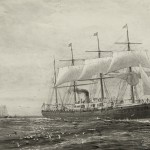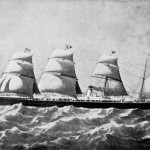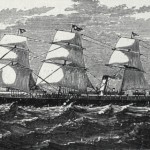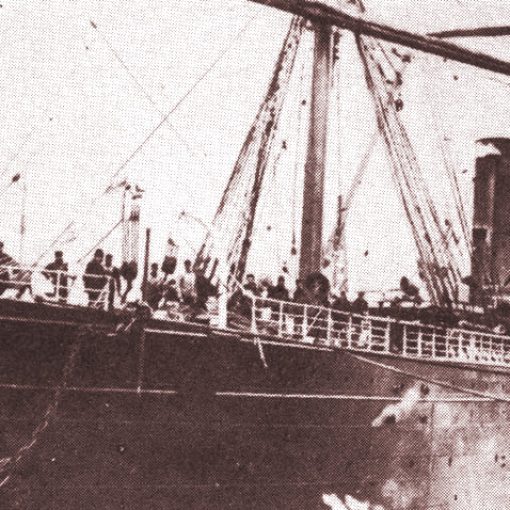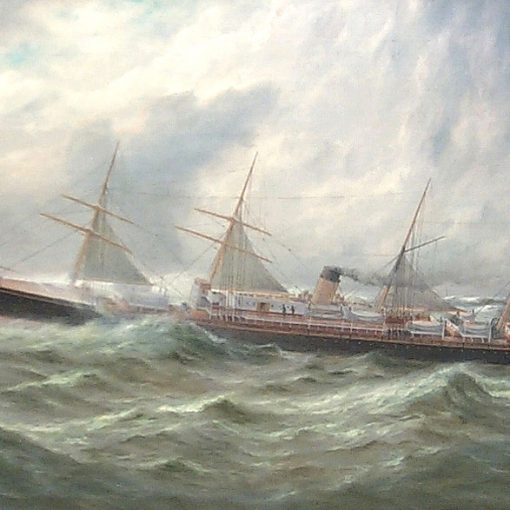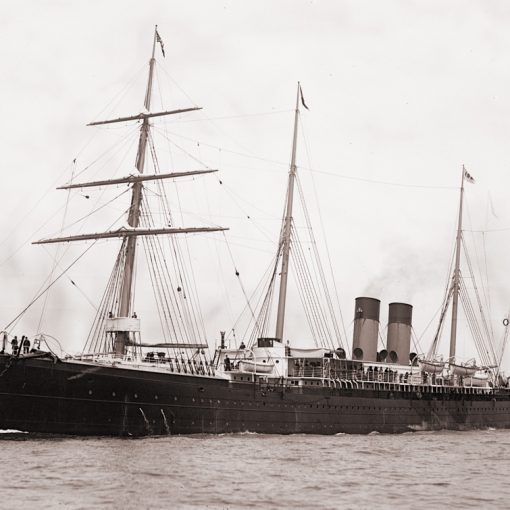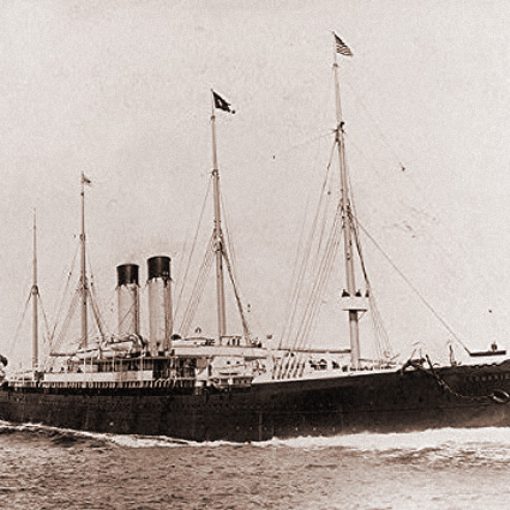1871 – 1896
The name ‘White Star’ first appeared in 1849, when the youngsters John Pilkington and Henry Threlfall Wilson advertised their company, the ‘White Star Line of Boston Packets’, and its first ship owned by Pilkington and Wilson – the three masted barque Iowa – in the Liverpool newspapers. Even though the company advertised in Britain, the ports of call were strangely all situated along the American coast. The two men made enough profit in the Americas to consider an expansion, but their only concern was – what destination would they choose?
In the 1850s, gold was discovered in Australia. This required many large ships to carry all the miners searching for fortune. This was the perfect opportunity for the two-year-old White Star Line of Boston Packets, and the company put their ships into the Australian trade. In 1852, the company’s name was changed to ‘White Star Line of Australian Packets’.
At a parallel course, Thomas Henry Ismay, had started his shipping-company career, when he became a partner in the ‘Nelson, Ismay & Co.’ By the mid-sixties, the latter company and the White Star Line had developed an unofficial relationship; sometimes helping arranging each other’s voyages. This ‘partnership’ grew deeper and in 1869, the two companies joined forces, forming the new ‘Oceanic Steam Navigation Company’, also known as the ‘White Star Line’ – a company that would become a very fabled one.
The new company agreed with the shipbuilding company ‘Harland & Wolff’, to have them build all their ships, providing they would be the best on the seas. Soon the White Star Line ordered the first vessel from Harland & Wolff. She was to be named Oceanic, consequent to the company’s name. The Oceanic was the first in a quartet of sisters, all of similar characteristics. The other three sisters appeared frequently until February 1872.
On August 27, 1870, the Oceanic was launched. The ship was of a totally new breed. She had been put together by the absolutely best material available. Some noteworthy features on board the Oceanic was for instance her railings that had replaced the old bulwarks, and her large dining saloon that measured 80×40 feet where every passenger had his own chair. The White Star Line had not feared any costs in achieving the most modern and beautiful ship upon the waves. The press noted the ship’s appearance, which in their words, ‘resembled an Imperial yacht’. The ship was made for a glorious future, but time would prove different.
The Oceanic’s maiden voyage started off from Liverpool on March 2, 1871. Unbelievably for the White Star Line, the ship only carried 64 paying passengers, and only hours off Liverpool, the Oceanic developed engine problems, so serious that the ship could not continue to her destination port of New York, but had to return to Liverpool instead. The maiden voyage was resumed on March 16. When the Oceanic finally reached New York she was the subject of celebration and over 50,000 people visited the ‘finest ship on the transatlantic route’.
The Oceanic did not become the great success the managers of the White Star Line had hoped, but she had set new standards in shipbuilding technology, and no passenger would any longer accept a new ship of the old breed. To remedy some of the Oceanic’s teething troubles, several changes in the construction were made during the ship’s first annual overhaul in January 1872. A large forecastle was added with a breakwater in order to keep the front of the ship relatively free from water in stormy weather; a problem that hitherto had haunted the Oceanic. The engine power was enlarged with increased steam pressure and the assistance of two new boilers. In order to keep the two extra boilers, the coal bunkerage was enlarged. In addition to this, the vessel’s masts were shortened to reduce an annoying tendency to roll.
Three years later the White Star Line introduced their new Blue Riband-champion; the first Britannic. With this ship in White Star service, the Oceanic began to seem somewhat outdated. In March she made her final sailing between Liverpool and New York. The transatlantic route was handed over to the new prime ships. The Oceanic was chartered by the Occidental & Oriental S.S. Co. for San Francisco-Yokohama-Hong Kong service. The ship’s officers were still from White Star but the crewmen were Chinese. The funnel of the vessel remained White Star-buff, but instead of the usual red-and-white company flag, the O. & O. flag was used. When the Oceanic had left Liverpool and arrived at Hong Kong it was revealed that no ship had managed such a distance with that average speed before. The Oceanic could now also claim to be a record-holder, just like the likes of her younger company-mate; the Britannic. The speed of the ship continued to prove worthiness, when in December 1876, she made yet another record crossing, this time between Yokohama and San Francisco.
With no major mishaps in her history, the Oceanic continued her service into the 1880s. Unfortunately, no ship seems to escape accidents, and this went for the Oceanic as well. On August 22, 1882, the ship collided just off the Golden Gate Bridge with the coastal liner City of Chester, which sank with a loss of sixteen lives.
In some last efforts of showing her worth, the Oceanic made a last record crossing between Yokohama and San Francisco in November 1889. The voyage took 13 days, 14 hours and 5 minutes. Six years later the Oceanic was returned under White Star management. The company sent the ship to Harland & Wolff for re-engining, but after having gone through the ship, the plans of putting the Oceanic back into service was abandoned. The old ‘greyhound’ was sold for £8,000 for breaking up on the Thames. On February 10, 1896, the Oceanic left Belfast under tow by the Dutch tug Oceaan. The time had come to usher in a new era in shipbuilding.
Specifications
- 420.3 feet (128.4 m) long
- 40.85 feet (12.5 m) wide
- 3,707 gross tons
- 2×2 cylinder type engines powering a single propeller
- 14.5 knot service speed
- Passenger capacity of 1,166 people

